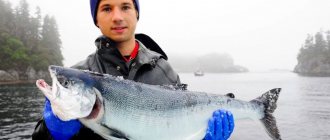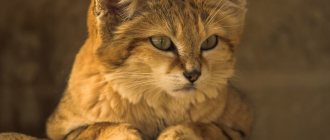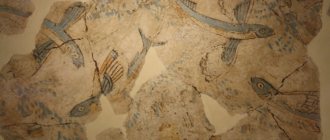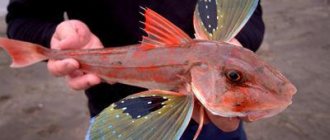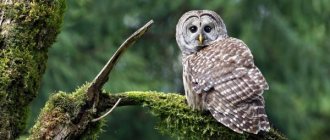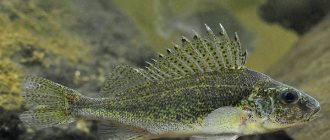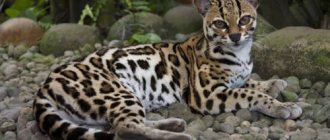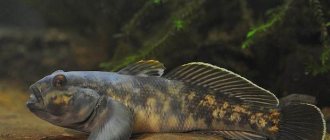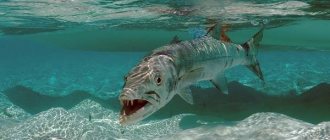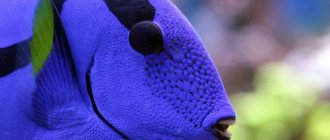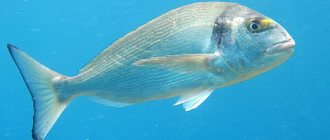| Class | Ray-finned |
| Squad | Gobiiformes |
| Family | Single-tube |
| Genus | Firebrands |
| View | Rotan |
| Security status | Trash fish |
| The average size | 7 cm, 350-400 g |
| Lifespan | 5-7 years |
| What does it eat? | Eggs, tadpoles, small fish, larvae, small amphibians |
| Optimal feeding time | Morning day Evening |
| Enemies | Perch, pike, catfish |
| What do they bite on? | Maliki, small fish, minced fish |
Rotan stands out for its special appearance. The large mouth with numerous small teeth arranged in several rows inspires fear. The species is considered a parasite and destroys large numbers of small fish.
In small bodies of water it can significantly reduce the number of other species. People call the predator a pensioner, a round log, a toad, a crabbill, a grassweed, a wrasse and other similar names. The most commonly used are rotan, ratan and firebrand.
Origin of the species and description
Initially, the rotan fish lived on the Amur, and later appeared in freshwater reservoirs with fresh water. The exact origin is unknown; there are guesses about the distribution of the predator. Initially it was an aquarium fish brought from India. She is very beautiful and unpretentious; she reproduced well in an aquarium with minimal equipment. They called it the Amur bull.
Aquarists decided to conduct an experiment to determine the degree of survival of the species, and released some of the firebrands into a pond near Moscow. The individuals overwintered well and took over the reservoir. Later they began to expand their range, choosing wetlands with standing water.
Spread throughout the Moscow and Leningrad regions. Gradually, rotan fish populated the rivers of European countries and fresh water bodies of Russia. It is widespread in the Far East.
The fish was called firebrand because of its structural features. The third part of the body is occupied by the head. The mouth is large with sharp teeth that are periodically renewed. Small eyes look forward. Acute vision allows you to quickly respond to prey. Outwardly similar to a goby, but belongs to the firebrand family. Fishermen who do not know what rotan looks like consider it a river goby.
Types of rotan
The type of rotan brought to Russia is called firebrand. However, there are a lot of alternative names: sandpiper, rooster, greenback, goby, grasshopper, farrier. Blacksmith, throat and wrasse are also on the list. The wide list of names is associated with the rapid spread of hitherto unknown fish.
They caught it in different places and called it differently. In fact, behind all the names there is one type of rotan.
The head is colored brown. The color varies depending on the body of water. In clean waters, rotans are lighter, and in dirty and muddy waters they are darker. Staying near the bottom, the fish camouflages itself, choosing the color closest to the environment.
In the photo there is black rotan
There are, for example, gray-green firebrands. These are invisible against the background of swampy silt. There are dirty brown and even almost black rotans.
The firebrand is a pot-bellied fish. It seems that the animal's belly is about to burst. Fighters for the prosperity of primordial species wish this for the hero of the article. Rotan is declared a parasite that destroys the usual inhabitants of fresh water bodies.
Firebrands begin to prey when their body is only a centimeter long. What does rotan fish eat? The hero of the article inflicts damage on the numbers of other species not so much by eating them themselves as by destroying the eggs of others. This is an easy, tasty and small prey for a miniature rotan.
Rotan is a predator that destroys the eggs of commercial fish
The expansion of rotan into the water bodies of the European part of Russia has a downside. Fish can be beneficial in cases where waters are overpopulated with other species. For example, there are too many crucian carp in the pond. There is not enough food for everyone. As a result, the crucian carp becomes smaller, unable to gain maximum weight.
By eating the fry of brooding fish, the firebrand controls their numbers. There is plenty of food for the dwindling population, and the crucian carp in the reservoir is gaining weight.
Outside Russia, two more species of rotans live. They inhabit the rivers and lakes of Asia, larger than firebrands. Otherwise, the differences between the species are insignificant, expressed in the color and size of the fins.
Appearance and features
The body is dense and slightly shortened. The scales do not shine. Color shades vary. The color depends on the light and the color of the bottom of the reservoir in which they live. Gray-green and dirty brown shades are more common. Pattern in the form of stripes and spots of various shapes. The abdomen is gray. During spawning, the body of males turns black, so those who do not know what rotan looks like consider it a different type of fish.
The gill covers have a soft spine turned backwards. The fins are tinted to match the body color and are transparent. The hind ones are longer than the front ones. The caudal and pectoral fins have a rounded shape. The abdominal ones are very small, paired, located next to the head.
The maximum size of an individual is 14-25 cm, but the firebrand rarely reaches this length. The average life span is 4-5 years, but in good conditions it lives up to 7 years. Weight 350-400 g. The fish are very hardy. They can withstand freezing of the pond to the bottom, their partial drying out, lack of oxygen, turbidity and water pollution.
Reproduction and lifespan
Russian rotans are called heads not only because of the size of the head. The association with coals in the stove also plays a role. During the breeding season, the inconspicuous and brown males of the species are covered with orange-red spots. With them, the dense body of the fish becomes like a burning firebrand.
Rotans reproduce in late spring - early summer. The water should warm up to 17-20 degrees. The mating games of firebrands last for several days. Fish spawn by attaching sticky mucus to floating objects or bottom stones and driftwood. Females try to find a secluded corner. This way the eggs have a better chance of turning into fry.
Rotan embryos need more oxygen than adult fish. Parents have to continuously fan the eggs with their fins. By creating a current, fish organize an “approach” of water with fresh oxygen.
The responsibility of caring for the eggs is assigned to the males of the firebrands. They not only fan the embryos, but also zealously protect them from predators, rushing to hit them with their massive forehead.
Rotans live from 4 to 7 years. In aquariums, with proper care, firebrands reach 9 years of age. However, modern aquarists, spoiled by brightly colored fish from overseas, rarely purchase firebrands for visual pleasure.
Where does rotan live?
It is unpretentious in terms of living and feeding conditions, but prefers floodplains with rich vegetation, oxbow lakes, and ponds with stagnant water. He treats the current with caution, tries not to swim close and avoids it.
Initially, the species was recorded in the Far East of the Russian Federation, northeastern China, the Amur basin, and northern North Korea. Later he populated Baikal and the reservoirs of St. Petersburg, where he was deliberately released.
Now the firebrand is observed in Northern Eurasia, the basins of the Danube, Dnieper, Volga, Don, Dniester rivers, and in most water bodies of Russia. Waterfowl contribute to the expansion of the population. They carry eggs stuck to their paws over long distances.
Distribution and habitats
Initially, rotan began to inhabit the reservoirs of the Amur River basin and the Far East. Rotan was also found in the northern regions of North Korea and northeast China. Most scientists consider the appearance of rotan in the waters of Lake Baikal in the 20th century to be biological pollution. And in 1916, rotan began to be bred in the reservoirs of St. Petersburg. Subsequently, this fish from these reservoirs spread throughout Northern Eurasia.
Rotan habitats
Today, the Volga, Dnieper, Don, Dniester, Danube, Irtysh, Ural, and Ob rivers are rich in rotan. Standing reservoirs are also rich in this fish. In such reservoirs, as a rule, there are no suitable conditions for other predators. Rotan is widely distributed in floodplain reservoirs during river floods. Rotan is actively dispersed by humans.
Rotan is one of the most unpretentious fish; it survives even in the dirtiest bodies of water. Not at all afraid of freezing. There have been cases where fish were discovered when cutting down ice. After thawing, rotan comes to life and begins to float. This survivability of rotan is explained by its ability to partially exchange gases through the skin.
What does rotan eat?
Tadpoles eat zooplankton. Grown-up babies consume benthos and invertebrates. Adults eat juveniles, amphibian tadpoles, insect larvae, newts and small fish. They are capable of eating small firebrands and their own fry; cannibalism is widespread. In small bodies of water, rotan fish reproduce well and destroy other species of fish.
Interesting!
Scientists call rotan a pest, as it adapts perfectly to any fresh body of water. It quickly destroys populations of other fish species in the area if there are no large predators in the habitat.
She is very gluttonous. Does not neglect leeches, earthworms, eggs and insects. It can consume minced meat, swallowing the bait deeply. He eats a large amount of food at one time, so his stomach increases 3 times. During the day it can eat 2-3 fish up to 4 cm long. It is easy to catch rotan with an ordinary fishing rod, stringing pieces of lard or raw meat onto a hook.
Side nod and winter fishing rod
Winter fishing rod with jig for perch and rotan.
We have combined these two types of gear due to the fact that they are very similar. More detailed article on winter fishing for rotan. Both here and here the same equipment and the same baits are used. The whole difference is that the fishing methods and the actual sizes of the rod differ.
The equipment of the nodding fishing rod in both cases is absolutely identical:
- Fishing rod.
- Nod.
- Fishing line.
- Spinner or jig.
- Bait.
The spinner or jig in this gear is used to visually attract rotan, and the bait itself forces the rotan to show itself and bite.
How to play?
The game itself is quite simple; you need to periodically pull the fishing rod, remembering to pause. Some fishermen in winter prefer to make several holes and walk from one to another, playing each one periodically.
Watch a video on catching rotan in the dead of winter on thick ice, youtube:
Fishing with live bait
If you decide to catch rotan with live bait, then the equipment is not particularly different from a standard fishing rod. It is equipped with the following elements:
- With a noticeable gatehouse;
- The standard line is about 0.2 mm.
- Sinker.
- Stopper.
- Matching hook.
The hook is placed on the baitfish's back and/or mouth and lowered into the hole. In this case, the depth should be selected in such a way that about 10-20 cm remains to the bottom. When catching rotan with live bait, you can catch a really large predator, although medium-sized predators are also caught with live bait.
Features of catching rotan
- This predator is liked by many anglers for its persistent and simple bite. He swallows the bait really deeply.
- In a reservoir it can be located in all layers , so when fishing you should select the most suitable depth.
- If the hooking was too early and the rotan broke, then you should not worry that it will go far. Often, if you lower the bait into the same place, the rotan will start biting again.
- This predator prefers quiet bodies of water, with virtually no current . If the reservoir does not freeze, then you can catch it throughout the whole year.
- It has been noted that large rotan prefers a “sandwich” rather than bait of the same type.
- In autumn and early winter, larger rotans prefer animal baits .
- He doesn’t pay much attention to the fishing line, so there’s no need to use too thin one.
- Rotan is very well caught in the presence of vegetation in the reservoir , because that's where he likes to hide.
- This predator usually bites where it stands. He waits for prey, and does not search for it throughout the entire body of water, like a perch.
- The most optimal time for catching rotan is April and May , when the reservoir is completely free of ice. The fact is that the fish strives to accumulate strength for spawning, so its gluttony is almost constant. And it is caught using completely different baits.
These are the most important features of a predator such as rotan, which should be taken into account in the process of preparing for fishing.
Features of character and lifestyle
Rotan is not picky about water temperature. It feels great in water at a temperature of +3⁰ - +40⁰. Allowed to be kept in an aquarium. For full development, 10 liters of water per individual is required. In an artificial environment, fish have brighter colors due to better lighting. It is recommended to provide plenty of cover and vegetation.
During the hunt, it floats unnoticed in the water, approaching the prey. When about 10 cm remains to the target, the predator makes a dash and swallows the prey without missing a beat. The victim does not have time to escape from him because he does not notice in a timely manner. The herb prefers dense thickets, which makes catching difficult. Gear easily gets tangled in mud and snags.
You can fish with a float rod and spinning rod at any depth, including in shallow water where the bottom is clearly visible. The predator is difficult to spot. Its presence can be determined by the shadow cast on the bottom.
If natural bait is not provided, artificial lures resembling worms and fry are thrown. It is recommended to choose bait made of edible rubber, since fish, when hunting, rely on the taste of their prey.
Fishing for rotan
There are a huge number of reviews from fishermen about rotan, both positive and negative. Some people are annoyed by the dominance of this omnivorous predator, while others, on the contrary, are excited by it, giving them hope of catching larger fish of other species.
Catching firebrands is especially popular in winter. During this period, the predator experiences a food shortage, becomes greedy, and gladly rushes to almost any bait. Therefore, even a novice beginner can catch it without much effort in winter.
Any bait of animal origin is used as bait for rotan: live bait, meat, maggots, worms, etc. When choosing bait of artificial origin, it is important to take into account the fact that rotan will not swim past the amplitude, irritating firebrand of the game.
The fish’s favorite places are heavily overgrown, littered, mully areas of the reservoir. Due to the fact that the firebrand is distributed extremely unevenly across the water area, you need to look for it by casting in different places.
Among the gear that fishermen use for fishing are:
- float rod. In this case, it is important to “play” with the float, constantly creating the appearance of movement of the bait.
- Spinning. Rotan bites especially actively on artificial, scented bait with a large amplitude of movement.
- Bottom fishing rod. With its help you can catch a larger specimen of fish, but it is more difficult to do this; a well-fed firebrand is located closer to the bottom, so in this case it is necessary to choose the right bait.
Social structure and reproduction
Two-year-old individuals are ready to breed. Mothers that have reached a length of 7 cm are capable of spawning. The firebrand spawns in May-June, choosing places with high vegetation. In males, the upper part of the head swells and the body turns black. One large female lays from 100 to 1 thousand eggs.
The masonry is attached to various objects and plants independently. The eggs are sticky, stick well, and can settle to the bottom, attaching to household waste that has settled at the bottom.
The male guards the eggs until the tadpoles develop. Then he changes his attitude towards the offspring, they become a target for hunting. To survive, tadpoles are forced to hide in algae and among various objects at the bottom. The fry eat only food of animal origin; as the individual grows, the size of the prey increases.
Lifestyle
A rotan's lifestyle
Prefers stagnant bodies of water, ponds and swamps. Very unpretentious to environmental conditions, especially to oxygen deficiency in water. Withstands almost complete drying and freezing of water bodies, burrowing into silt. Avoids bodies of water with fast and even moderate currents. Inhabits ponds, small, overgrown and swampy lakes, oxbow lakes. Leads a sedentary lifestyle, hunts like a typical ambush predator, hiding in dense thickets of underwater plants.
An interesting observation of the wintering of rotan in small additional reservoirs in the Amur basin was carried out by amateur fishermen. Rotan at the end of December forms large accumulations in cavities among the ice, filled with air-ice wet mass. With transparent ice, these accumulations are easily visible from the surface: the cavity in the ice in which rotans overwinter has the form of a hemisphere with a diameter of 20 cm to 2 m, its upper point is located 30-60 cm from the upper edge of the ice. The temperature in it is close to 0-1° C. The fish are in a state of stupor and, when taken out, move slightly. When placed in water, they quickly move away and begin to actively swim. In the subsidiary reservoirs of the Amur, rotan enters the ice at the end of December and wakes up from hibernation at the end of April. However, in the Moscow region and in a number of other reservoirs of the European part of Russia, rotan does not hibernate at all. On Moscow ponds, fishermen catch it all year round, including in winter. It feeds on animal food (benthos and, less frequently, plankton) of any available size, including juvenile fish and eggs.
Despite its small size, rotan is very voracious and almost omnivorous. Tadpoles are a favorite food at the beginning of summer. Fertility up to 1000 eggs. Portion spawning occurs in May-July at a water temperature of 15-20° C. It lays eggs on bottom objects (plant rhizomes, snags, stones), on the lower surface of objects floating in the water and leaves of aquatic vegetation. The male guards the clutch and young. The caviar is elongated, measuring 3.8 x 1.3 mm.
Population and species status
The rotan fish is considered a weed, as it reproduces very quickly and displaces other fish, including valuable species. In some reservoirs the status “Biological pollution by rotan” has been assigned. A decision was made to artificially reduce its population by catching adult fish in areas of excessive distribution in order to enable valuable species to restore their numbers.
Natural enemies of rotans
The voracious and cruel predator also has enemies!
Large predatory fish such as pike, snakehead, perch or eel hunt for rotan. Moreover, a larger representative of its species can kill a fish (don’t forget that firebrands eat each other).
Fry and small or weak fish are susceptible to attacks by predatory bugs. And of course, the natural enemy of rotan is man. And it’s not just fishermen who catch fish and eat them.
Often, due to the fact that rotan has displaced other species of fish from the territory of the reservoir, it is exterminated. If you don’t do this, the number of trash fish will continue to increase and perhaps there will be no room left for other types of fish.
Is this a predatory fish?
The rotan fish does not attack large specimens, so it is difficult to call it a classic predator that destroys everything. The number of crucian carp, carp and other fish is reduced due to the consumption of caviar and fry.
The herb brings benefits and harm at the same time. It is an active predator of small fish and can destroy the entire species in its habitat. The number of individuals in the reservoir decreases, the surviving fish receive more nutrition and grow larger.
The largest in the world
The standard size of this fish is small. The animal rarely grows more than 12-15 cm, and the weight at such sizes is 300-500 grams. But in reservoirs where fish have no natural enemies and there is good nutrition, the largest rotan grows up to 25 cm and weighs 400-500 grams.
Because of its huge head and mouth, the fish looks truly terrifying. Rotan fish has a menacing appearance and is even found in the hands of fishermen. Because of this, stories began to circulate about the animal that there were individuals with a maximum weight of up to 1 kg and a size of up to 70 cm. But given the size of the mouth and head of this animal, with such dimensions it could well bite off the hand or even the head of a fisherman.
In reality, the maximum weight of the largest fish in the world of this species was 550 grams. The hunter did not report the size of the fish, but with this weight the size will be slightly larger than the standard size of 25-27 centimeters.
Taste properties of rotan, can it be eaten?
Many people are interested in whether the herb is edible or not. It is valued by chefs for its dietary meat. It is stewed, fried, boiled and dried. There are practically no bones in the carcass; it is easy to clean from scales. The giblets are removed by making an incision in the abdomen along the head. Fried meat turns out sweetish.
Important!
Bones are usually removed during eating. It is not advisable to clean a small carcass from bones.
Boiled meat has a white-pink color and a delicate taste. There are very few large bones, so the fish is perfect for stews and canned food. Dietary meat is well digestible. 100 g contains 88 calories. Fish contains a lot of protein, vitamins A, E and D, as well as bromine, iron, copper, manganese, potassium and magnesium.
Is rotan fish edible or not?
It has excellent taste, and many fishermen consider it a delicacy. It has few bones and dietary meat, only 88 calories per 100 grams.
"Goloveshka" is great for:
- Extinguishing;
- Frying;
- Fish soup;
- Canned food.
The scales are easily removed, so cleaning will not take much time, which is valuable for housewives. The meat surprisingly does not smell like mud. So, contrary to various horror stories, the “firebrand” is not only edible, but also very tasty.
Read us in:
Yandex Zen
Source:
Rotan recipes
Fried firebrand. Select large specimens. Gutted carcasses can be cut into pieces, but it is better to fry them whole. The fish is well dredged in flour and fried on both sides until golden brown. Use vegetable or butter. To get a crispy crust, cover the pan with a lid 5 minutes before the end of cooking.
Firebrand omelette. The roasted carcasses are cut into pieces and placed in a frying pan. Beat eggs with milk. The resulting mixture is poured into a frying pan. You can add finely chopped green onions and other greens to it at your own discretion. Prepare in the same way as a traditional omelet with the lid closed.
Fish under marinade. The carcasses are boiled in salted water until cooked. Separate the bones by placing the meat pieces in a deep dish. Prepare the marinade. Finely chop the onion, grate 2 carrots. The vegetables are transferred to a frying pan and fried, tomato paste is added to them, about 3-4 spoons, and 1 spoon of vinegar and spices. The fillet is poured with marinade and allowed to brew for several hours. Suitable as a cold snack.
Fish salad with egg and cucumber. The carcasses are boiled or stewed until cooked. Disassemble into pieces, separating the bones, crush with a fork. Add chopped boiled egg and pickled cucumber cut into small cubes to the minced meat. Season with mayonnaise or special dressing. For dressing, take mustard, vegetable oil, a little salt, add pepper as desired.
Firebrand soup. Chop the potatoes and carrots into cubes in a saucepan of cold water. It is better to add dried dill and parsley to boiling water instead of fresh herbs. Add bay leaf and black peppercorns. Place the prepared fish pieces into the broth and cook for 20 minutes. You can add butter and sour cream to the finished dish.
Ear. Whole processed carcasses, turnips, carrots, parsley and celery roots, a medium onion, bay leaf, and black pepper are placed in a cauldron with cold water. After boiling, add diced potatoes. Cook for about 60 minutes. The finished dish is sprinkled with finely chopped parsley and dill.
Fish ears. Belarusian dumplings are called ears. Minced fish is prepared from pre-boiled fish. Fry onions. Add 1 cup of boiled mushrooms and onions to the minced meat. Pepper, add salt and mix. The resulting filling is used to fill dumplings.
Baking in the oven. Prepared headless carcasses are rubbed with a small amount of salt. Let them sit until they are salted. Rinse off the salt and dab with a paper towel. Preheat the oven to 200⁰. Pour vegetable oil into a glass baking dish, spreading it over the bottom in a thin layer. Place the fish and cover it with vegetable oil so that the fish does not dry out or burn. Cover with foil and bake for 30-40 minutes. Then remove the foil and bake until golden brown for about 10 minutes.
The firebrand is considered a universal fish. You can prepare almost any dish from it: cutlets, casseroles, canned fish and pies. There are many recipes for experienced cooks and those who do not know how to cook rotan. The fish is combined with a side dish and can be used as an independent holiday dish.
Culinary value of rotan
Many fishermen consider rotan a trash fish, something like a frog. Like, the French eat them too, but somehow they don’t feel like trying them. And it’s completely in vain. The culinary value of rotan lies in the fact that it has excellent tasting white meat, reminiscent of chicken. Unlike crucian carp, it does not have such an abundance of small bones, and it smells much less like a swamp. So you can easily fry rotan, dry it and cook fish soup from it. All this is, of course, true if you haven’t caught rotan somewhere behind garages on the outskirts of the city in a puddle of fuel oil.
Folk recipe.
Small rotan produces excellent homemade sprats. To do this, the fish must be cleaned, decapitated, gutted and thoroughly washed under running water. Then place the carcasses in layers in a pan, topping with chopped carrots and onions. All this is poured with vegetable oil and stewed for six hours. Experts say that if you use olive oil, sprats cannot be distinguished from Riga sprats.
Beneficial features
Rotan fish is widely used in cooking. The taste of rotan meat is not inferior to prepared dishes from cod fish species. This fish can be cooked in different ways. First courses, cutlets, salads, etc. are prepared from rotan.
The beneficial properties of rotan are due to the content of a large amount of easily digestible and low-calorie proteins. 100 grams of product contain no more than 90 kcal. Recommended for preparing dietary dishes. Vitamins A, D, E contained in rotan meat help strengthen the immune system. The microelements necessary to maintain health have a beneficial effect on the body: iron, potassium, manganese, etc.
Spawning
Rotan becomes sexually mature by the end of the second year of life. Rotan spawning begins after the water temperature has stabilized above 18 degrees. Typically, favorable conditions for rotan reproduction occur in the second half of May. Spawning can continue until the second half of June.
This period is easy to determine by the appearance of the fish. Males turn black and have a noticeable growth on their head. Females are painted in lighter colors.
The male chooses the place to lay eggs. Usually this is underwater vegetation, stones or other bottom obstacles in warm shallow water. The female spawns eggs in portions with breaks of up to 2 weeks. The total fertility does not exceed 1 thousand eggs. Males remain in the spawning grounds and guard the eggs until the fry hatch. But after the embryos appear, the males forget about responsibility and begin to actively eat their own offspring.
The primary food of the fry is zooplankton. As they grow older, the diet of the fry expands with benthos and small invertebrate organisms. Adults turn into omnivorous predators. The basis of nutrition is small fish, amphibian larvae, newts, eggs of other fish, etc.
Unpleasant habits
The fish's unattractive appearance matches his character. Rotan is called the “lazy glutton”, as he prefers to wait for his prey, hiding in the shade of grass and debris at the bottom of the reservoir. There is no shortage of potential food; rotan eats everything: small river plankton, caviar, fry and small fish. Rotan does not disdain its relatives. Yes, this is a cannibal fish.
